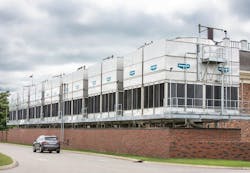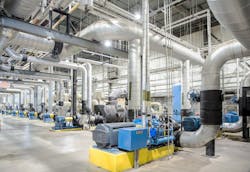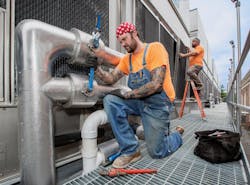Music City Resort Breathes Easier After Cool Upgrade
Today, Nashville is known as the heart of country music. But that wasn’t always the case.
The turning point came in 1925, when “Music City, USA” saw completion of The Grand Ole Opry. This truly kick-started the music industry in Tennessee, making Nashville the epicenter of the country music universe it is today.
More recently, its economic growth has outpaced many other cities nationwide, and tower cranes can still be seen across the downtown skyline; signs of a strong local economy. Hotels and resorts, both new and existing, have expanded and improved to handle the influx of tourism.
One small part of the citywide improvement was a large mechanical system enhancement at one iconic, 4.5-million-sq-ft resort on the city’s eastern side. Its cooling system had been in need of new heat rejection equipment to battle the area’s hot, humid summers.
But the scope of the hydronic system retrofit required was daunting. The resort’s massive cooling load calls for 24,000 gallons of chilled water per minute, enough to fill two Olympic sized swimming pools in less than an hour. To make the project even more interesting, the system had to remain online without interruptions to serve the 3,000+ guest rooms and suites, 15 restaurants, and the rest of the resort facilities.
Ultimately, success came by way of a cohesive team – including reps, engineers, mechanical contractors, resort maintenance personnel and manufacturers – that operated like a well-oiled machine.
Retiring Old Cooling Towers
“The resort’s cooling towers had reached their expected lifecycle,” said Jason Dawkins, project manager at Nashville Machine Company, Inc. “They’d been considering replacement of the towers for almost a decade. The resort suffered a severe flood in 2010, and replacing them was discussed at the time. Ultimately, they were reconstructed, but after eight years, maintenance costs to battle leaks and fan failures were rising. We’ve done many projects at the resort, so we were familiar with the cooling system long before the retrofit began.”
Nashville Machine was founded in 1887 as a machine shop. As the city grew and expanded, so did the firm, branching into commercial HVAC, plumbing and fabrication. The company provides pre-fabrication, pipe-fitting, welding and sheet metal for other mechanical shops, in addition to its own projects. As a union shop, Nashville Machine typically employs between 500 and 1,000 tradesmen and tradeswomen.
At the resort, their task was to remove and replace the four original cooling towers, with a total of 19 cells. The units were adjacent to a mechanical/service building located just east of the resort proper. Overall, the system also includes seven, 1,200-ton water-cooled chillers to provide cooling capacity to fan coil units and air handlers throughout the sprawling complex.
These components, along with large pumps that serve the cooling towers, were still serviceable. Chilled water is piped roughly 1,000 feet from the mechanical room to terminal units within the resort.
The design phase for the retrofit included input from Nashville Machine, Beech Construction Services (the resort’s chosen general contractor), Mechanical Resources Group (MRG), a Nashville-based commercial manufacturer’s rep firm, and I.C. Thomasson & Associates, an employee-owned engineering consulting firm also based in Nashville.
“Our in-house CAD department worked with MRG to complete the 3D modelling for the retrofit,” said Miller Orr, Nashville Machine’s project manager. “Throughout two phases, we replaced the original towers with new stainless steel EVAPCO models for the same cooling capacity.”
Counterflow Solutions
The original spec included crossflow cooling towers, but given the multiple goals set by the resort – ease of maintenance, aesthetics, and ideal discharge air movement – MRG’s design team worked with EVAPCO to assemble a new spec using counterflow models.
“In conventional crossflow cooling towers, air is drawn across the tower’s heat transfer media (fill), perpendicular to the direction of the cascading cooling water,” explained Brett Alexander, applications engineer at EVAPCO. “In a counterflow tower, air is induced up through the fill in the opposite direction of the falling water. Our counterflow models also feature sun-tight louvers, helping stem the growth of algae in the basin of the tower. That can’t be accomplished with a crossflow tower.”
“After learning what the resort was hoping to accomplish, it became apparent that a counterflow tower design would better serve the property,” said Phil Collison, director of replacement at EVAPCO. “At first, there was resistance from the director of physical plant, simply because his earlier experience with cooling towers involved crossflow designs.”
MRG organized a trip with several of the resort’s key maintenance personnel to visit EVAPCO’s manufacturing headquarters in Maryland, allowing them to see up close the potential advantages of counterflow towers in person.
One of the benefits that counterflow units provided was to simplify the maintenance process. The original crossflow towers included 19 cells lined up in a row, with no space between. Components could only be accessed from either end of the 192-foot row of towers, requiring shutdown of each tower, each time that personnel passed through to perform tasks.
“The size and layout of the new counter-flow towers provides 360-degree access to the water basins of each tower via access corridors between the towers,” said Matt Fruetel, Business Development VP at MRG, which has carried the EVAPCO line for 12 years. “Maintenance personnel no longer have to duck-walk through water basins to reach any of the cells.”
Tower aesthetics was a significant factor, too. Because the cooling towers are installed just above ground level, they’re easily seen from the street. Scale buildup or icicles on the fill material of the original towers were impossible to hide. But in a counterflow tower design, the heat transfer sections are fully enclosed.
“Another design consideration was avoiding air recirculation,” explained Fruetel. “During the winter, visible plume from the original towers showed that the units were recirculating discharge air.”
This challenge came from the fact that the old towers sat below the roof level of the mechanical building, and because the cross-flow towers only drew air from two sides, one of which was against the side of the building.
“The new towers, which were designed to have a smaller footprint and greater height, clear the top of the building,” said Collison. “Pulling air from four sides is a big advantage, too. To match the original capacity, the resort could have selected smaller box sizes and larger fan motors. That would have reduced the initial cost. But they opted for larger boxes, focusing on energy efficiency.”
Phased Replacement
“The largest upfront challenge was tower sequencing with new steel, while keeping the plant online to provide enough heat rejection capacity to support the hotel loads,” explained Dawkins. “Good planning with the general contractor and execution by field personnel, including but not limited to Wolfe and Travis, Inc. for power requirements, and MRG for product support and tower start up.”
The original tower cells were taken offline and replaced in two phases. Temporary piping was used to maintain service to the resort’s chiller plant. New dunnage was fabricated and the original tower basin steam heat system was modified to serve the new cells.
“We replaced everything from the strainer on,” said Orr. “Prefabricating components in our shop helped reduce downtime. A total of 9,000 tons of cooling capacity is now provided by stainless steel EVAPCO AT towers.
“The footprint of these units needed to fit very specific dimensions on top of a raised platform behind the mechanical building,” said Fruetel. “We selected EVAPCO’s AT line because of the huge range of models and box sizes available, including the largest counterflow towers on the market.”
The counterflow design of the AT towers saves water and increases efficiency, and with Cooling Tower Institute certification, designers could rely on the provided cooling performance data. MRG’s knowledge of the line streamlined both the design phase and start-up.
From start to finish, the system was operational in about six months. The investment made by the resort will pay dividends by reducing energy, water and sewer expenses, and, in the end, all of the resort’s expectations for the project were met or exceeded.
“Today, the new system looks infinitely better from the street, maintenance has been simplified, and there are no air recirculation issues,” said Orr. “The client is thrilled with the result.”
The author is public relations director for Common Ground, a trade communications firm. Email him at [email protected].





